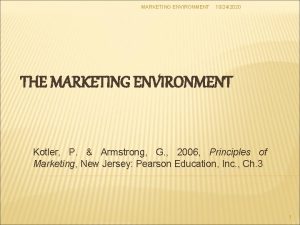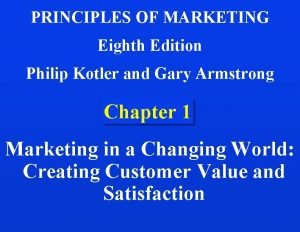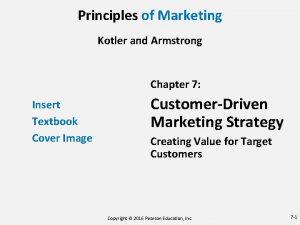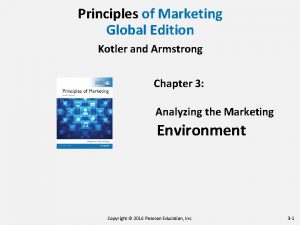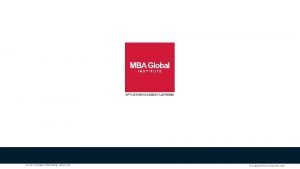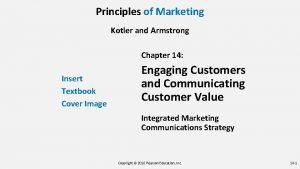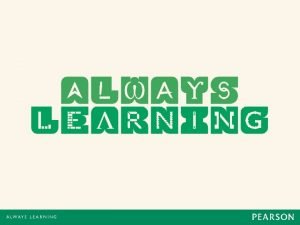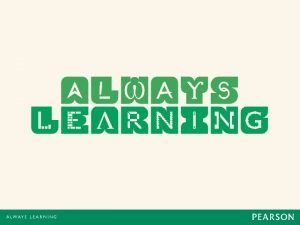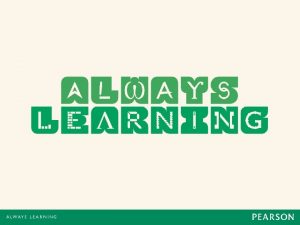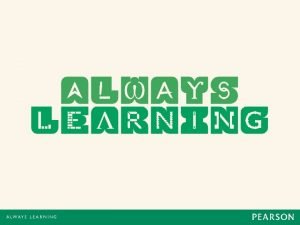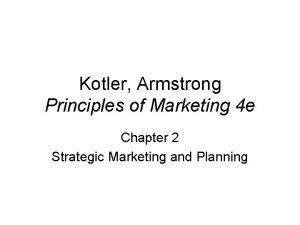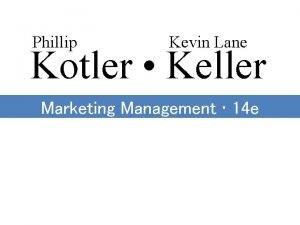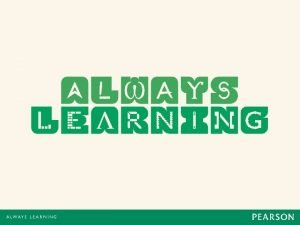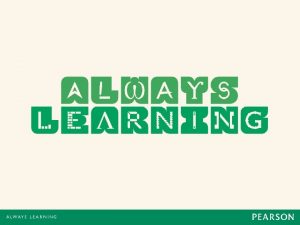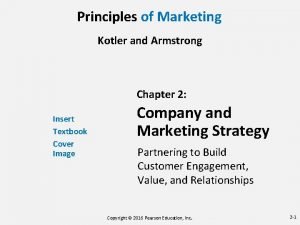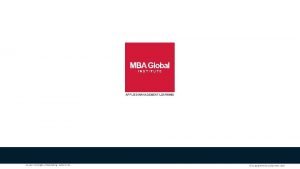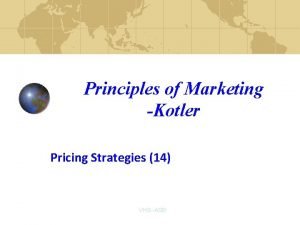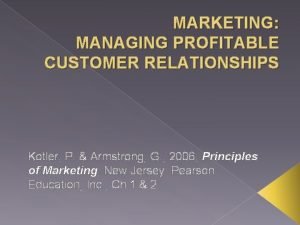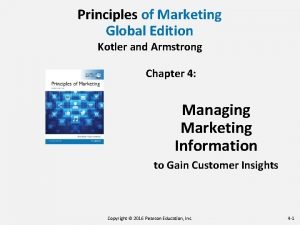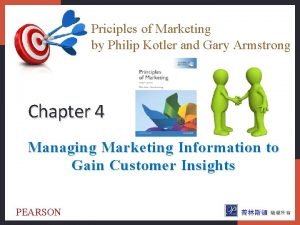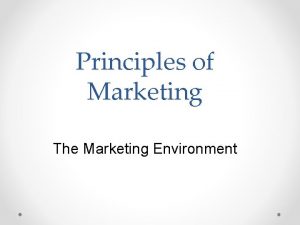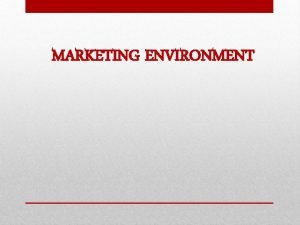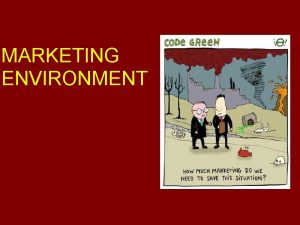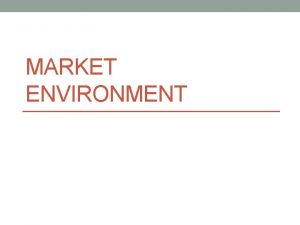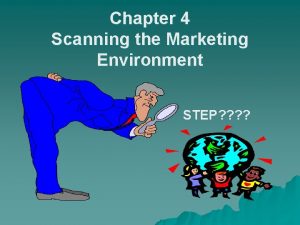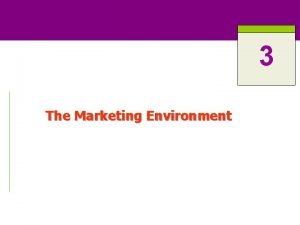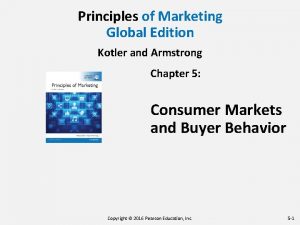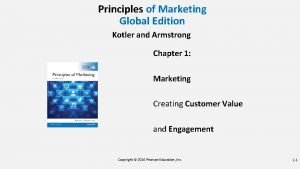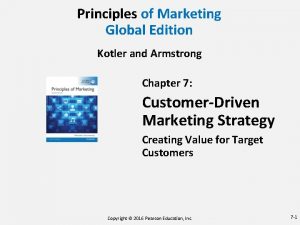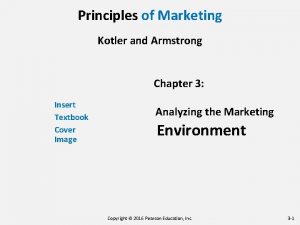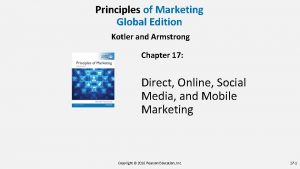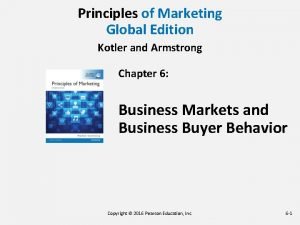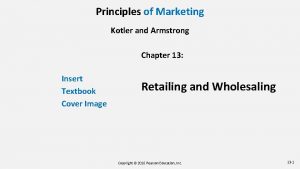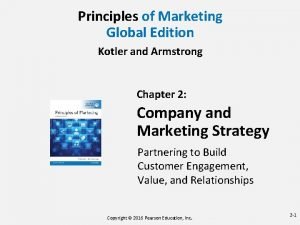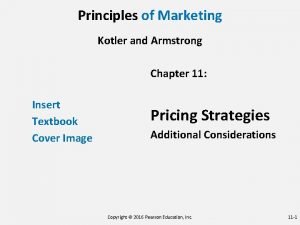Principles of Marketing The Marketing Environment Kotler on




















































- Slides: 52

Principles of Marketing The Marketing Environment

Kotler on Marketing Today you have to run faster to stay in place.

The Marketing Process

Learning Objectives • Define the meaning and scope of the marketing environment • Consider the factors in the marketing environment and their effect on marketing planning and management • Examine the challenges of the marketing environment and how marketers respond to these




























The Marketing Environment • The factors and forces outside marketing that affect marketing management’s ability to build and maintain successful relationships with target customers.


The Microenvironment • The actors close to the company that affect its ability to serve its customers - the company, suppliers, marketing intermediaries, customer markets, competitors, and publics. o Internal environment o Suppliers o Marketing intermediaries o Customers o Competitors o Publics

Company’s internal environment R&D Purchasing Finance Top management Manufacturing Marketing Accounting

Intermediaries • Firms that help the company to promote, sell, and distribute its goods to final buyers. o o Resellers Distribution firms Marketing service agencies Financial intermediaries

Competitors • Budget competitors o It is not only important to focus on your direct competitors, but also all marketers that target your customers and therefore compete with you for their income. • Substitute competitors • Brand competitors o Direct competition, category competition

Customers • Consumer markets • Business markets • Reseller markets • Government markets • International markets

Publics • Any group that has an actual or potential interest in or impact on an organization’s ability to achieve its objectives. o Financial publics which affect the company’s ability to obtain funds. o Media publics which carry news, features and editorial opinion for or against the company.

Publics o Government publics o Citizen-action publics: interest groups o Local publics o General publics (perceived image) o Internal publics: the company’s employees and managers

Porter’s 5 Competitive Forces New entrants Threat of New Entrants Suppliers Bargaining Power of Suppliers Industry Competitors Threat of Substitutes Bargaining Power of Buyers

Macroenvironment • The larger societal forces that affect the microenvironment. o o o Demographic Economic Natural Technological Political Cultural Attention: macroenvironments influence not only companies, but also marketing micro environments

Demographic Environment • • the number and quality of the population Changing age structure of the population The changing family Geographic shifts in population A better-educated and more white-collar population Increasing diversity ………

Economic Environment • Factors that affect supply and demand patterns. o GDP growth rate, unemployment rate, inflation rate, interest rate, exchange rate, income growth rate, Global challenges of integration (EU) or expansion (BRIC) • Rich richer, poor even poorer o Business life cycles • Prosperity Recession Depression Recovery • Some academic terms: o o nominal income vs. real income disposable personal income discretionary income Engel ratio

Natural Environment • Natural resources that are needed as inputs by marketers or that are affected by marketing activities. • Three trends in the natural environment o Shortages of raw materials o Increased pollution o Increased government intervention

Technological Environment • Forces that create new technologies, creating new product and market opportunities. o Positive results • Transportation methods, Internet & information technology -- retailing • Inventory control systems, etc. o Negative results • Unemployment • Misuse of information, etc.

Political Environment • Laws, government agencies, and pressure groups that influence and limit various organizations and individuals in a given society. o Increasing legislation & regulation (tobacco industry) o Emphasis on business ethics and social responsibility

Cultural Environment • Institutions and other forces that affect society’s basic values, perceptions, preferences, and behaviors. o Values • Core values vs. secondary values o Custom o Taboos

Analyze the Marketing Environment • SWOT Analysis Strengths • • • What does the company do well? Is the company strong in its market? Does the company have a strong sense of purpose and the culture to support that purpose? Weaknesses • • • Threats Opportunities • • • Are industry trends moving upward? Do new markets exist for the company's products/services? Are there new technologies that the company can exploit? What does the company do poorly? What problems could be avoided? Does the company have serious financial liabilities? • • • What are the competitors doing well? What obstacles does the company face? Are there troubling changes in the company's business environment (technologies, laws, and regulations)?

Analyze the Marketing Environment • Dell’s SWOT analysis Strengths • Sell directly to consumers • Keep costs below competitors' costs Weaknesses • Opportunities • • • Consumer desire for one-stop shopping Consumers know what they want to buy Internet could be a powerful marketing tool No Strong relationships with computer retailers Threats • • Competitors have stronger brand names Competitors have strong relationships with computer retailers

Environmental Responses • Reactive response: Change your marketing mix in response to environmental changes. • Proactive response: Try to change the environment.

Questions & Answers
 Philip kotler marketing environment
Philip kotler marketing environment Principles of marketing by philip kotler
Principles of marketing by philip kotler Principles of marketing chapter 7
Principles of marketing chapter 7 Kotler and armstrong principles of marketing
Kotler and armstrong principles of marketing Marketing information system kotler
Marketing information system kotler Integrated marketing communication ppt kotler
Integrated marketing communication ppt kotler Capturing marketing insights
Capturing marketing insights Benefits of secondary research
Benefits of secondary research Recruise meaning
Recruise meaning Marketing management (arab world edition)
Marketing management (arab world edition) What is the value delivery process
What is the value delivery process Marketing management (arab world edition) philip kotler
Marketing management (arab world edition) philip kotler Principles of marketing arab world edition
Principles of marketing arab world edition New consumer capabilities in marketing
New consumer capabilities in marketing Marketing information management definition
Marketing information management definition Marketing planning process kotler
Marketing planning process kotler Marketing information systems and marketing research
Marketing information systems and marketing research Kotler definition of marketing
Kotler definition of marketing Kotler and keller 2012
Kotler and keller 2012 Marketing management (arab world edition) philip kotler
Marketing management (arab world edition) philip kotler Marketing management (arab world edition)
Marketing management (arab world edition) Kotler segmentation
Kotler segmentation Marketing chapter 2
Marketing chapter 2 Marketing kotler
Marketing kotler Kotler pricing strategy
Kotler pricing strategy Marketing kotler
Marketing kotler Armstrong
Armstrong Administração de marketing kotler e keller
Administração de marketing kotler e keller Principles of marketing research
Principles of marketing research Marketing research process kotler
Marketing research process kotler Financial environment of business
Financial environment of business Principles of marketing module 2 answer key
Principles of marketing module 2 answer key Land and environment court planning principles
Land and environment court planning principles Hình ảnh bộ gõ cơ thể búng tay
Hình ảnh bộ gõ cơ thể búng tay Lp html
Lp html Bổ thể
Bổ thể Tỉ lệ cơ thể trẻ em
Tỉ lệ cơ thể trẻ em Gấu đi như thế nào
Gấu đi như thế nào Chụp tư thế worms-breton
Chụp tư thế worms-breton Chúa sống lại
Chúa sống lại Môn thể thao bắt đầu bằng từ chạy
Môn thể thao bắt đầu bằng từ chạy Thế nào là hệ số cao nhất
Thế nào là hệ số cao nhất Các châu lục và đại dương trên thế giới
Các châu lục và đại dương trên thế giới Công thức tiính động năng
Công thức tiính động năng Trời xanh đây là của chúng ta thể thơ
Trời xanh đây là của chúng ta thể thơ Cách giải mật thư tọa độ
Cách giải mật thư tọa độ 101012 bằng
101012 bằng độ dài liên kết
độ dài liên kết Các châu lục và đại dương trên thế giới
Các châu lục và đại dương trên thế giới Thơ thất ngôn tứ tuyệt đường luật
Thơ thất ngôn tứ tuyệt đường luật Quá trình desamine hóa có thể tạo ra
Quá trình desamine hóa có thể tạo ra Một số thể thơ truyền thống
Một số thể thơ truyền thống Cái miệng xinh xinh thế chỉ nói điều hay thôi
Cái miệng xinh xinh thế chỉ nói điều hay thôi
